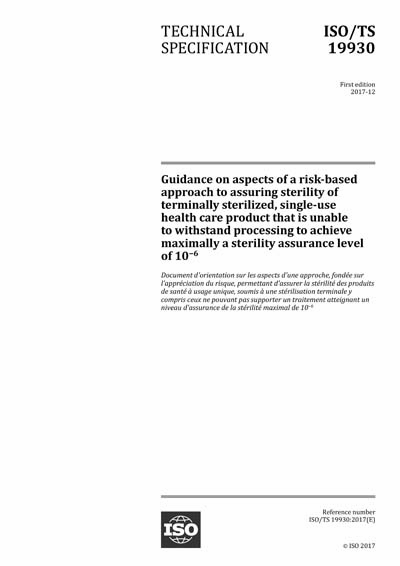Most recent
ISO/TS 19930:2017
Guidance on aspects of a risk-based approach to assuring sterility of terminally sterilized, single-use health care product that is unable to withstand processing to achieve maximally a sterility assurance level of 10-6
ISO/TS 19930:2017 provides guidance on identifying the aspects to be considered as part of a risk-based approach to selecting a sterility assurance level (SAL) for terminally sterilized, single-use health care product that is unable to withstand processing to achieve maximally a SAL of 10−6.
In addition, this document provides
a) background information on the assurance of sterility and sterility assurance level, and
b) guidance on strategies that can allow the achievement of a maximal SAL of 10−6.
ISO/TS 19930:2017 describes the elements of a quality management system which are applied to enable the appropriate selection of a SAL for terminally sterilized, single-use health care product that is unable to withstand processing to achieve maximally a SAL of 10−6.
NOTE It is not a requirement of the International Standards for development, validation and routine control of a sterilization process to have a full quality management system. Attention is drawn to the standard for quality management systems (see ISO 13485) that controls all stages of the lifecycle of health care product.
ISO/TS 19930:2017 is applicable to sterilization processes in which microorganisms are inactivated by physical and/or chemical means.
ISO/TS 19930:2017 does not apply
- to selecting a maximal SAL greater than 10−6 for health care product that is able to withstand processing to achieve maximally a SAL of 10−6;
- in cases where a maximal SAL of 10−6 is required and an alternative SAL is not allowed;
- in cases where a maximal SAL of greater than 10−6 (e.g. 10−3) has been accepted by regulatory authorities within their jurisdiction for health care product for defined use;
- to the sterilization of used or reprocessed health care product;
- to sterilization of health care product by filtration.
ISO/TS 19930:2017 does not describe detailed procedures for assessing microbial inactivation.
ISO/TS 19930:2017 does not specify requirements for the development, validation and routine control of a process for inactivating the causative agents of spongiform encephalopathies such as scrapie, bovine spongiform encephalopathy and Creutzfeldt-Jakob disease. Specific recommendations have been produced in particular countries for the processing of materials potentially contaminated with these agents.
NOTE See also ISO 22442‑1, ISO 22442‑2 and ISO 22442‑3.
ISO/TS 19930:2017 does not supersede or modify published International Standards for particular sterilization processes. ISO/TS 19930:2017 neither recommends a SAL for a given health care product nor identifies a maximal SAL for a health care product to be labelled "sterile".
NOTE These are matters for regulatory authorities and can vary from country to country.
International Organization for Standardization [iso]

